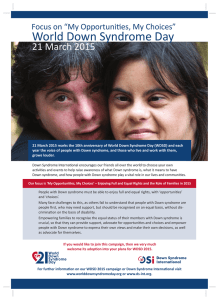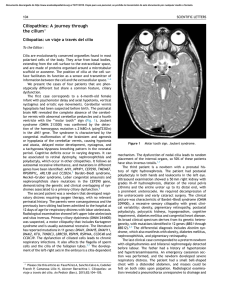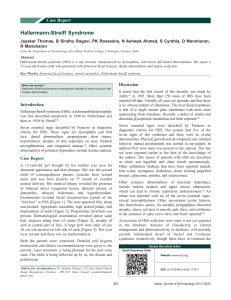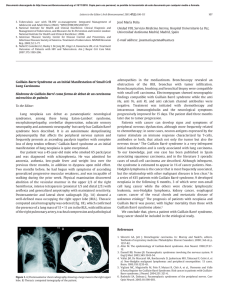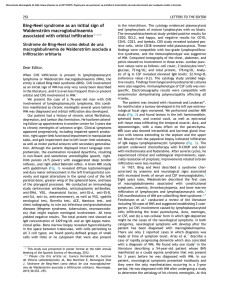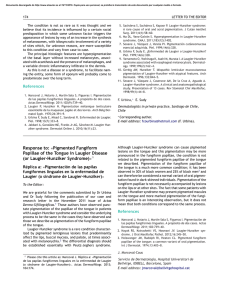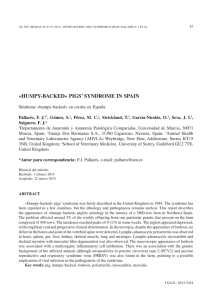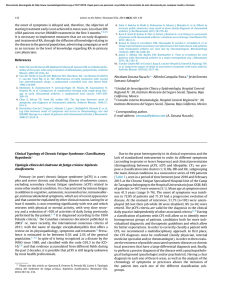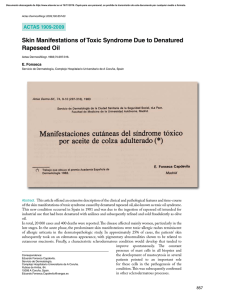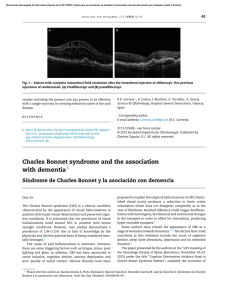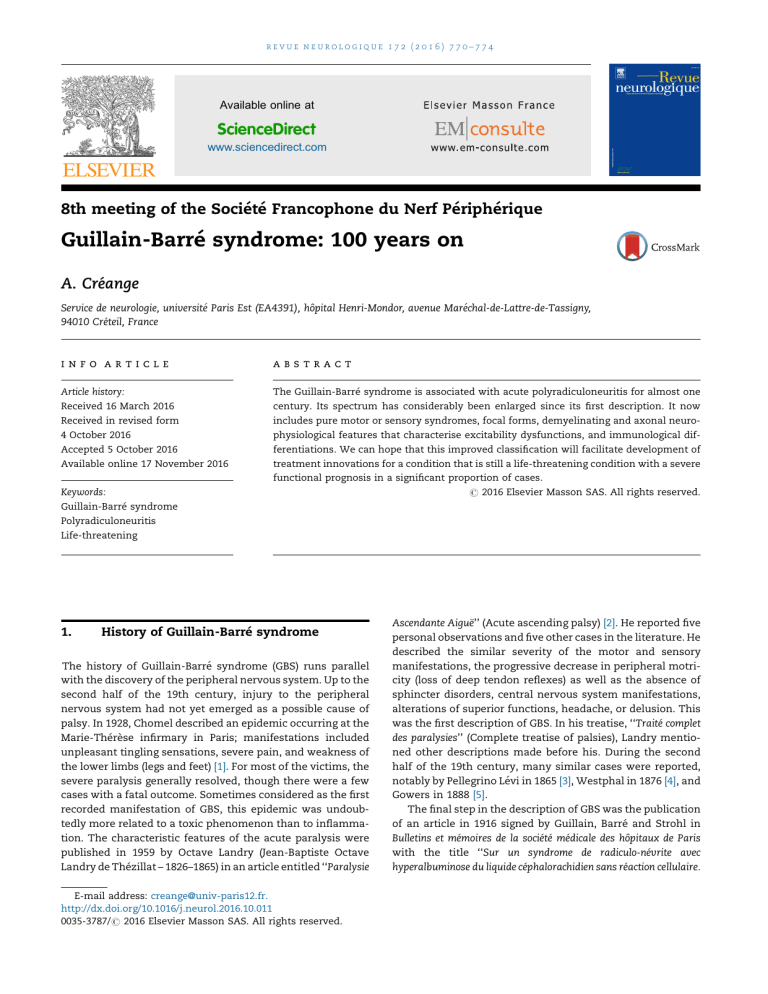
revue neurologique 172 (2016) 770–774 Available online at ScienceDirect www.sciencedirect.com 8th meeting of the Société Francophone du Nerf Périphérique Guillain-Barré syndrome: 100 years on A. Créange Service de neurologie, université Paris Est (EA4391), hôpital Henri-Mondor, avenue Maréchal-de-Lattre-de-Tassigny, 94010 Créteil, France info article abstract Article history: The Guillain-Barré syndrome is associated with acute polyradiculoneuritis for almost one Received 16 March 2016 century. Its spectrum has considerably been enlarged since its first description. It now Received in revised form includes pure motor or sensory syndromes, focal forms, demyelinating and axonal neuro- 4 October 2016 physiological features that characterise excitability dysfunctions, and immunological dif- Accepted 5 October 2016 ferentiations. We can hope that this improved classification will facilitate development of Available online 17 November 2016 treatment innovations for a condition that is still a life-threatening condition with a severe functional prognosis in a significant proportion of cases. Keywords: # 2016 Elsevier Masson SAS. All rights reserved. Guillain-Barré syndrome Polyradiculoneuritis Life-threatening 1. History of Guillain-Barré syndrome The history of Guillain-Barré syndrome (GBS) runs parallel with the discovery of the peripheral nervous system. Up to the second half of the 19th century, injury to the peripheral nervous system had not yet emerged as a possible cause of palsy. In 1928, Chomel described an epidemic occurring at the Marie-Thérèse infirmary in Paris; manifestations included unpleasant tingling sensations, severe pain, and weakness of the lower limbs (legs and feet) [1]. For most of the victims, the severe paralysis generally resolved, though there were a few cases with a fatal outcome. Sometimes considered as the first recorded manifestation of GBS, this epidemic was undoubtedly more related to a toxic phenomenon than to inflammation. The characteristic features of the acute paralysis were published in 1959 by Octave Landry (Jean-Baptiste Octave Landry de Thézillat – 1826–1865) in an article entitled ‘‘Paralysie E-mail address: [email protected]. http://dx.doi.org/10.1016/j.neurol.2016.10.011 0035-3787/# 2016 Elsevier Masson SAS. All rights reserved. Ascendante Aiguë’’ (Acute ascending palsy) [2]. He reported five personal observations and five other cases in the literature. He described the similar severity of the motor and sensory manifestations, the progressive decrease in peripheral motricity (loss of deep tendon reflexes) as well as the absence of sphincter disorders, central nervous system manifestations, alterations of superior functions, headache, or delusion. This was the first description of GBS. In his treatise, ‘‘Traité complet des paralysies’’ (Complete treatise of palsies), Landry mentioned other descriptions made before his. During the second half of the 19th century, many similar cases were reported, notably by Pellegrino Lévi in 1865 [3], Westphal in 1876 [4], and Gowers in 1888 [5]. The final step in the description of GBS was the publication of an article in 1916 signed by Guillain, Barré and Strohl in Bulletins et mémoires de la société médicale des hôpitaux de Paris with the title ‘‘Sur un syndrome de radiculo-névrite avec hyperalbuminose du liquide céphalorachidien sans réaction cellulaire. revue neurologique 172 (2016) 770–774 Remarques sur les caractères cliniques et graphiques des réflexes tendineux’’ (On a radiculo-neuritis syndrome with hyperalbuminosis of the cerebrospinal fluid without cell reaction. Remarks on the clinical and graphic characteristics of the tendon reflexes) [6]. Guillain and Barré collaborated in the neurology center of the 6th army in Amiens. Strohl was a radiologist in the same military hospital [7]. Their work was published in 1920 in a text entitled war-related neurology work that briefly described GBS [8], differentiating Landry’s palsy that developed after antityphoid vaccination and from neurological palsy secondary to toxic gas exposure. It was suggested that the fact André Strohl ‘‘strayed’’ from neurology towards other aspects of medicine such as electrophysiology, radiology, or physical medicine, or his young age – he was 29 and had just received his degree at the time of the description of the syndrome – or perhaps his background (he was from Alsace) would explain why he lost the honors of history in the description of GBS. In any case, the term GBS was introduced for the first time in Paris in 1927 by Draganescu and Claudian who described a radiculoneuritis occurring after staphylococcal osteomyelitis [9]. The case report was presented at the French Society of Neurology after an introduction by Barré. It was at this time that Strohl’s name was omitted, both in the description of the syndrome and in the publication the authors cited. During the First World War, just after the Battle of the Somme, the three authors published their palsy cases observed in two soldiers seen within one month. One can imagine the conditions under which the three physicians worked to obtain this history-making observation. In similar circumstances, Clovis Vincent, head physician of the neurology center of the 9th military region of Tours, developed a ‘‘faradic’’ method called ‘‘torpedoing’’ that consisted in treating ‘‘paralytics’’ and ‘‘plicaturés’’ (camptocormia) suffering from ‘‘obusite’’ (post-traumatic stress) with 100 mA electrical shocks that were later qualified as torture [10]. The first soldier was a hussar who developed a stinging sensation of the lower limbs with muscle weakness without prior infection. One month later, he exhibited deficiency in the distal muscles of the legs, abolition of the tendon reflexes, and moderate sensory deficiency. There was no sphincter disorder. One month later, he had improved and was able to walk for one hour. He was not returned to the war front, but was sent to the rear for rest. The second case was much more acute. An infantry soldier presented with motor deficiency that made him fall backward when he put on his backpack. One month later, the deficit improved. Recordings of the tendon reflexes showed a 2-to-3-fold increased latency and decreased amplitude. The authors concluded that the conduction velocity of the central part of the reflex had to be severely hampered, but also considered that the muscle must have been involved since response to direct muscle percussion was diminished. But the most important point, the point that drew attention to these cases, was the increased albumin concentration in the cerebrospinal fluid, despite the lack of any cellular reaction as seen in ‘‘radiculoneuritis’’. In the first case, the cerebrospinal fluid assay reported 2.5 g/L (0.85 g/L in the second case) associated with a normal cell count. The authors emphasized the importance of this finding that is never 771 Box 1. Synonymes of Guillain-Barré syndrome. Acute ascending paralysis of Landry. Acute polyneuritis with fever. Polyradiculoneuritis with albumin-cytology dissociation. Acute infectious polyneuritis. GBS. Landry Guillain-Barré syndrome. Landry Guillain-Barré and Strohl syndrome. Idiopathic polyneuritis. Acute demyelinating inflammatory polyradiculoneuritis. observed in pure peripheral nerve injury. They also emphasized the good ‘‘lifelong’’ prognosis (Box 1). 2. Diagnosis and clinical forms Over the years, refinements were added to the classification of GBS. The diagnostic criteria started to include the diverse presentations observed in different patients. As early as 1938, then in 1953, Guillain had recognized several forms of GBS and proposed a clinical classification that took into account four presentations: the form affecting the lower limbs; the spinal and brain stem form; the diencephalic form; and the polyradiculoneuropathy form with perturbed consciousness [11,12]. Twenty years later, Miller Fisher described the syndrome that later took on his name and that had a presentation similar to the diencephalic form described by Guillain. Meanwhile, Bickerstaff presented a syndrome similar to polyradiculoneuropathy with perturbed consciousness. Diagnostic criteria were proposed in 1978 [13]. The different presentations observed led to the proposal for specific criteria in 1990 designating pure motor, pure sensory, Miller Fisher, and other localized forms [14]. A new revision was published in 2001 taking into account neurophysiological results and describing several subtypes: sensorimotor; pure motor; Miller Fisher [15]. The axonal or demyelinating classification can be associated with these motor or sensorimotor forms. A collaborative work published in 2011 also took into account neurophysiological criteria [16]. Even more recently, a collaborative group examined the possibility of basing diagnosis on clinical elements for the different subtypes of GBS and Miller Fisher syndrome, the latter syndrome known to evolve into the other (Table 1) [17]. 3. Neurophysiological classification This improvement in the clinical classification requires neurophysiological precisions including descriptions of the demyelinating and axonal features not apprehended by diagnostic and prognostic questions. GBS can be axonal or demyelinating. The subtypes of GBS and Miller Fisher syndrome also have certain neurophysiological features of the axonal or demyelinating type, but the axonal or demyelinating 772 revue neurologique 172 (2016) 770–774 Table 1 – Subtypes of Guillain-Barré syndrome and Miller Fisher syndrome. Guillain-Barré syndrome Pure sensory Guillain-Barré syndrome Pure motor Guillain-Barré syndrome (motor demyelinating neuropathy) Bilateral facial palsy with paresthesia Acute axonal motor neuropathy Pharyngeal-cervical-brachial weakness Acute pharyngeal weakness Paraparetic Guillain-Barré syndrome Acute motor neuropathy with conduction blocks Acute axonal sensorimotor neuropathy Miller-Fisher syndrome Acute ataxic neuropathy Acute ophthalmoplegia Acute ptosis Acute mydriasis Bickerstaff encephalitis Acute ataxia with hypersomnolence characteristic is not linked with prognosis. Thus, axonal forms can recover rapidly or progress towards degeneration. Similarly, conduction blocks can resolve rapidly or evolve towards axonal degeneration. The initial clinical manifestations of GBS are more the consequence of nerve excitability disorders than definitive histological alterations of the nerves [18]. Nerve lesions are related to hormonal, cellular, innate immunity or adaptive immunity inflammatory mechanisms. 4. Biology and immunology of GBS Some of the first messages remain. Thus, many authors still talk about the albumin-cytology dissociation despite the fact that for decades the routine technique has been to assay total protein and not albumin. Today the dissociation is defined by increased cerebrospinal fluid protein content with a cell count below 50/mm3 [16]. What is the prognostic value of an elevated protein level? This question requires a prospective study. Immunology findings can also be used to establish another classification. Certain anti-ganglioside antibodies are associated with certain GBS phenotypes, e.g. focal forms of GBS or even Miller Fisher syndrome [17]. More generally, the anti-ganglioside or anti-nodes of Ranvier antibodies identified [19] result from a normal immune reaction to an antigen since the IgM then IgG pattern describes an adaptive immune response. 5. Etiological diagnosis There is a long list of potential differential diagnoses for GBS. New cases of GBS have been described in recent years. Thus, infections by various viruses – dengue, hepatitis E, chikungunya, West Nile, and most recently Zika – can be implicated. Clinicians should also remember that acute focal neuropathies corresponding to limited forms of GBS must not be ruled out too quickly. Certain questions remain open concerning the differential diagnosis of GBS versus chronic polyradiculoneuritis. These are recurrent forms of GBS exhibiting posttreatment fluctuations, or acute forms of chronic polyradiculoneuritis [20]. 6. Pathophysiology Two elements must be distinguished. It is important to recognize that the mechanisms underpinning the inflammation are different from their physiological consequences affecting the nerve. Certain immunological mechanisms involve perturbed innate immunity plus elements of adaptive immunity. For innate immunity, dendritic cells, complement fractions, mast cells, monocytes/macrophages, and certain toll-like receptors with a favoring effect play an important role. Early activation of adaptive immunity is involved, as shown by IL17 and IL22 secretion, CD4(+)CD25(+) regulator T-cell anomalies, and, of course, the presence of anti-ganglioside and anti-nodes of Ranvier protein IgG. This immune reaction results from the encounter with an antigen that has passed the first line of defense, i.e. the pharyngeal or digestive mucosa. Several arguments are in favor of a cross-reactivity phenomenon, especially in the cases of Campylobacter jejuni diarrhea with certain glycated (anti-GM1) or protein nerve antigens [21]. Other humoral factors of innate immunity and adaptive immunity participate in the nerve lesions, e.g. pro-inflammatory cytokines (TNFa). For the nerve, the consequences are multifocal demyelinating lesions developing via cellular (macrophage) or hormonal (cytokines, proteinases) mechanisms. The lesions may be focal, affecting the nodes of Ranvier and the neuromuscular junction (nerve endings) leading to excitability disorders related to anti-ganglioside antibodies, antibodies with no specifically recognized antigen, or anti-protein antibodies (nodo-paranodopathy) [19]. 7. Prognosis The idea that the prognosis is good was important for the early authors and remains so today despite reports of mortality rates above 4% in expert centers, disability rates reaching nearly 15%, and cases of prolonged disability with diminished strength, pain, fatigue, and need for occupational readjustments in 40% of cases [22]. Several elements affecting prognosis have been identified including older age, diarrhea as a triggering factor, important motor deficit and disability (MRC < 30), hospital admission, short interval between motor symptom onset and hospital admission, mechanical ventilation, and absence of motor action potential on neurophysiological recordings [22]. High serum glucose levels are associated with more severe disease. revue neurologique 172 (2016) 770–774 Simple clinical scores (e.g. EGRIS) can be determined at admission to assess the short-term risk of intubation. EGRIS combines items for older age, rapid disease progression, disease severity (GBS score), presence of triggering diarrhea, positive Campylobacter jejuni or cytomegalovirus serology, or the absence of prior respiratory morbidity, as well as inability to raise the head off the bed, elevated transaminase level, and vital capacity < 60% [23,24]. For the mid- and long-term prognosis, the EGOS (determined two weeks after admission) and the mEGOS (determined at one week) provide an assessment of the capacity to walk at 6 months or 4 weeks, respectively [25,26]. 8. Treatment No revolution has taken place in the treatment of GBS in the recent years. Intravenous immunoglobulins or plasma exchange remain the mainstay treatments. Two studies conducted in Europe and Japan are under way to test eculizumab, a complement anti-activator. There remains the question of the usefulness of a second immunoglobulin infusion for GBS. It is also raised in the case of a suspected chronic demyelinating neuropathy with an acute onset. Despite the absence of evidence from a comparative trial, a second infusion could be proposed if the baseline and postinfusion IgG concentrations vary little [27] or if in the presence of post-treatment clinicalseverity fluctuations [28]. It was the advent of the first laboratory tests that led to the definition of GBS. Making its way through the 20th century, GBS took a lot of discussion, and a few battles among international experts – and among the different schools of thought in France – to finally achieve full recognition. In an era when the number of diseases known by their eponym is declining, it must be remembered that GBS probably would not exist without the strong will of its first two authors. Today GBS englobes a large spectrum of syndromes illustrated by a century of clinical, neurophysiological and immunological refinements. For the upcoming years, we can hope that the significant progress recently made in our understanding of the pathophysiological mechanisms underpinning GBS will enable more targeted and more effective treatments. Disclosure of interest The author received departmental research grants from Biogen-Idec, CSL-Behring, GE Neuro, Novartis, Octapharma and expert testimony from Novartis, CSL Behring, Genzyme. references [1] Chomel J. De l’épidémie actuellement régnante à Paris. J Hebdomadaire Med 1928;1:332–9. [2] Landry O. Note sur la paralysie ascendante aiguë. Gazette Hebdomadaire Med Chir 1859;6:472–88. [3] Levi P. Contribution à l’étude de la paralysie ascendante aiguë ou extenso progressive aiguë. Arch Gen Med 1865;5:129–47. 773 [4] Westphal C. Ueber einige Fälle von acuter tödlicher Spinallähmung (sogenannter acute aufsteigender Paralyse). Arch F Psychiat 1876;6:765–822. [5] Gowers WK. A manual of diseases of the nervous system. Philadelphia: Blakinston; 1888. [6] Guillain G, Barré JA, Strohl A. Sur un syndrome de radiculonévrite avec hyperalbuminose du liquide céphalorachidien sans réaction cellulaire. Remarques sur les caractères cliniques et graphiques des réflexes tendineux. Bull Soc Med Hop Paris 1916;40:1462–70. [7] Hughes RAC. History and definition. In: Hughes RAC, editor. Guillain-Barré syndrome. Berlin: Springer-Verlag; 1992. p. 1–18. [8] Guillain G, Barré JA. Travaux neurologiques de guerre. Paris: Masson et Cie; 1920. [9] Draganescu S, Claudian J. Sur un cas de radiculo-névrite curable (SGB) apparue au cours d’une ostéomyélite du bras. Rev Neurol 1927;2:517–9. [10] Tatu L, Bogousslavsky J, Moulin T, Chopard JL. The ‘‘torpillage’’ neurologists of World War I: electric therapy to send hysterics back to the front. Neurology 2010;75:279–83. [11] Guillain G. Considérations sur le syndrome de Guillain et Barré. Ann Med 1953;54:81–92. [12] Guillain G. Les polyradiculonévrites avec dissociation albuminocytologique et à évolution favorable (syndrome de Guillain et Barré). Synthèse générale de la discussion. J Belge Neurol Psychiatr 1938;38:323–9. [13] Asbury AK, Arnasson BG, Karp HR, McFarlin DE. Criteria for diagnosis of Guillain-Barré syndrome. Ann Neurol 1978;3:565–6. [14] Ropper AH, Wijdicks EFM, Truax B. Guillain–Barré Syndrome. F.A. Davis; 1990. [15] Van der Meche FG, Van Doorn PA, Meulstee J, Jennekens FG. Diagnostic and classification criteria for the Guillain-Barre syndrome. Eur Neurol 2001;45:133–9. [16] Sejvar JJ, Kohl KS, Gidudu J, et al. Guillain-Barre syndrome and Fisher syndrome: case definitions and guidelines for collection, analysis, and presentation of immunization safety data. Vaccine 2011;29:599–612. [17] Wakerley BR, Uncini A, Yuki N. Guillain-Barre and Miller Fisher syndromes – new diagnostic classification. Nat Rev Neurol 2014;10:537–44. [18] Boerio-Gueguen D, Ahdab R, Ayache SS, et al. Distal nerve excitability and conduction studies in a case of rapidly regressive acute motor neuropathy with multiple motor conduction blocks. J Peripher Nerv Syst 2010;15:369–72. [19] Devaux JJ, Odaka M, Yuki N. Nodal proteins are target antigens in Guillain-Barre syndrome. J Peripher Nerv Syst 2012;17:62–71. [20] Sung JY, Tani J, Park SB, Kiernan MC, Lin CS. Early identification of ‘acute-onset’ chronic inflammatory demyelinating polyneuropathy. Brain 2014;137:2155–63. [21] Loshaj-Shala A, Regazzoni L, Daci A, et al. Guillain Barre syndrome (GBS): new insights in the molecular mimicry between C. jejuni and human peripheral nerve (HPN) proteins. J Neuroimmunol 2015;289:168–76. [22] Rajabally YA, Uncini A. Outcome and its predictors in Guillain-Barre syndrome. J Neurol Neurosurg Psychiatry 2012;83:711–8. [23] Sharshar T, Chevret S, Bourdain F, Raphael JC. Early predictors of mechanical ventilation in Guillain-Barre syndrome. Crit Care Med 2003;31:278–83. [24] Walgaard C, Lingsma HF, Ruts L, et al. Prediction of respiratory insufficiency in Guillain-Barre syndrome. Ann Neurol 2010;67:781–7. [25] van Koningsveld R, Steyerberg EW, Hughes RA, Swan AV, van Doorn PA, Jacobs BC. A clinical prognostic scoring system for Guillain-Barre syndrome. Lancet Neurol 2007;6:589–94. 774 revue neurologique 172 (2016) 770–774 [26] Walgaard C, Lingsma HF, Ruts L, van Doorn PA, Steyerberg EW, Jacobs BC. Early recognition of poor prognosis in Guillain-Barre syndrome. Neurology 2011;76:968–75. [27] Kuitwaard K, de Gelder J, Tio-Gillen AP, et al. Pharmacokinetics of intravenous immunoglobulin and outcome in Guillain-Barre syndrome. Ann Neurol 2009;66:597–603. [28] van Doorn P, Ruts L, Jacobs BC. Clinical features, pathogenesis, and treatment of Guillain-Barré syndrome. Lancet Neurol 2008;7:939–50.
